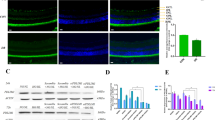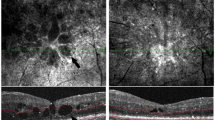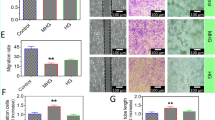Abstract
Diabetic retinopathy (DR), a microvascular complication characterized by abnormal angiogenesis, is the most common reason for irreversible blindness. Glycoprotein non-metastatic melanoma protein B (GPNMB), as a transmembrane protein, was found to be associated with angiogenesis. This study aims to investigate the role of GPNMB in DR. The levels of GPNMB and Integrin β1 were detected by real-time PCR and western blot and were found to be increased in human retinal microvascular endothelial cells (HRMECs) with high glucose (HG, 25 mmol/L) treatment. Knockdown of GPNMB was mediated by lentivirus carrying shRNA targeting GPNMB in vivo and in vitro. Functional experiments, including cell counting kit-8 (CCK-8), scratch, and tube formation assays, showed the anti-proliferative, anti-migrative, and anti-angiogenic roles of GPNMB knockdown in HRMECs using the lentivirus system following HG challenge. Additionally, increased GPNMB levels were detected in the retina of DR rats induced by a single intraperitoneal injection of streptozotocin (60 mg/kg) using real-time PCR, western blot, and immunofluorescence assays. Downregulation of GPNMB inhibited the angiogenesis and vascular endothelial growth factor production in the retina of rats with DR. Furthermore, overexpression of Integrin β1 led to increased angiogenesis in DR. Integrin β1 was indicated as a target protein of GPNMB. Upregulated-Integrin β1 restored GPNMB knockdown-induced inhibition of cell viability, migration, and tube formation in HRMECs. In conclusion, we provide evidence for the angiogenic role of GPNMB and demonstrate that silencing GPNMB may represent a therapeutic potential in the treatment of DR.





Similar content being viewed by others
Data availability
Data in this study is available from the corresponding author.
References
Duh EJ, Sun JK, Stitt AW (2017) Diabetic retinopathy: current understanding, mechanisms, and treatment strategies. JCI Insight. https://doi.org/10.1172/jci.insight.93751
Teo ZL, Tham YC, Yu M, Chee ML, Rim TH, Cheung N, Bikbov MM, Wang YX, Tang Y, Lu Y, Wong IY, Ting DSW, Tan GSW, Jonas JB, Sabanayagam C, Wong TY, Cheng CY (2021) Global prevalence of diabetic retinopathy and projection of burden through 2045: systematic review and meta-analysis. Ophthalmology 128:1580–1591. https://doi.org/10.1016/j.ophtha.2021.04.027
Antonetti DA, Silva PS, Stitt AW (2021) Current understanding of the molecular and cellular pathology of diabetic retinopathy. Nat Rev Endocrinol 17:195–206. https://doi.org/10.1038/s41574-020-00451-4
Brownlee M (2005) The pathobiology of diabetic complications: a unifying mechanism. Diabetes 54:1615–1625. https://doi.org/10.2337/diabetes.54.6.1615
Mrugacz M, Bryl A, Zorena K (2021) Retinal vascular endothelial cell dysfunction and neuroretinal degeneration in diabetic patients. J Clin Med. https://doi.org/10.3390/jcm10030458
Weterman MA, Ajubi N, van Dinter IM, Degen WG, van Muijen GN, Ruitter DJ, Bloemers HP (1995) nmb, A novel gene, is expressed in low-metastatic human melanoma cell lines and xenografts. Int J Cancer 60:73–81. https://doi.org/10.1002/ijc.2910600111
Selim AA (2009) Osteoactivin bioinformatic analysis: prediction of novel functions, structural features, and modes of action. Med Sci Monit 15(2):19–33
Ren F, Zhao Q, Liu B, Sun X, Tang Y, Huang H, Mei L, Yu Y, Mo H, Dong H, Zheng P, Mi Y (2020) Transcriptome analysis reveals GPNMB as a potential therapeutic target for gastric cancer. J Cell Physiol 235:2738–2752. https://doi.org/10.1002/jcp.29177
Monteiro MB, Pelaes TS, Santos-Bezerra DP, Thieme K, Lerario AM, Oba-Shinjo SM, Machado UF, Passarelli M, Marie SKN, Correa-Giannella ML (2020) Urinary sediment transcriptomic and longitudinal data to investigate renal function decline in type 1 diabetes. Front Endocrinol (Lausanne) 11:238. https://doi.org/10.3389/fendo.2020.00238
Hu H, Li Z, Lu M, Yun X, Li W, Liu C, Guo A (2018) Osteoactivin inhibits dexamethasone-induced osteoporosis through up-regulating integrin beta1 and activate ERK pathway. Biomed Pharmacother 105:66–72. https://doi.org/10.1016/j.biopha.2018.05.051
Silva R, D’Amico G, Hodivala-Dilke KM, Reynolds LE (2008) Integrins: the keys to unlocking angiogenesis. Arterioscler Thromb Vasc Biol 28:1703–1713. https://doi.org/10.1161/ATVBAHA.108.172015
Mia MS, Jarajapu Y, Rao R, Mathew S (2021) Integrin beta1 promotes pancreatic tumor growth by upregulating kindlin-2 and TGF-beta receptor-2. Int J Mol Sci. https://doi.org/10.3390/ijms221910599
Lu Q, Xie Z, Yan C, Ding Y, Ma Z, Wu S, Qiu Y, Cossette SM, Bordas M, Ramchandran R, Zou MH (2018) SNRK (sucrose nonfermenting 1-related kinase) promotes angiogenesis in vivo. Arterioscler Thromb Vasc Biol 38:373–385. https://doi.org/10.1161/ATVBAHA.117.309834
Byzova TV, Goldman CK, Pampori N, Thomas KA, Bett A, Shattil SJ, Plow EF (2000) A mechanism for modulation of cellular responses to VEGF: activation of the integrins. Mol Cell 6:851–860
Eilken HM, Adams RH (2010) Dynamics of endothelial cell behavior in sprouting angiogenesis. Curr Opin Cell Biol 22:617–625. https://doi.org/10.1016/j.ceb.2010.08.010
Zhang YX, Qin CP, Zhang XQ, Wang QR, Zhao CB, Yuan YQ, Yang JG (2017) Knocking down glycoprotein nonmetastatic melanoma protein B suppresses the proliferation, migration, and invasion in bladder cancer cells. Tumour Biol 39:1010428317699119. https://doi.org/10.1177/1010428317699119
Hu X, Zhang P, Xu Z, Chen H, Xie X (2013) GPNMB enhances bone regeneration by promoting angiogenesis and osteogenesis: potential role for tissue engineering bone. J Cell Biochem 114:2729–2737. https://doi.org/10.1002/jcb.24621
Narasaraju T, Shukla D, More S, Huang C, Zhang L, Xiao X, Liu L (2015) Role of microRNA-150 and glycoprotein nonmetastatic melanoma protein B in angiogenesis during hyperoxia-induced neonatal lung injury. Am J Respir Cell Mol Biol 52:253–261. https://doi.org/10.1165/rcmb.2013-0021OC
Mao XB, You ZP, Wu C, Huang J (2017) Potential suppression of the high glucose and insulin-induced retinal neovascularization by Sirtuin 3 in the human retinal endothelial cells. Biochem Biophys Res Commun 482:341–345. https://doi.org/10.1016/j.bbrc.2016.11.065
Covassin LD, Villefranc JA, Kacergis MC, Weinstein BM, Lawson ND (2006) Distinct genetic interactions between multiple Vegf receptors are required for development of different blood vessel types in zebrafish. Proc Natl Acad Sci U S A 103:6554–6559. https://doi.org/10.1073/pnas.0506886103
Almasry SM, Habib EK, Elmansy RA, Hassan ZA (2018) Hyperglycemia alters the protein levels of prominin-1 and VEGFA in the retina of albino rats. J Histochem Cytochem 66:33–45. https://doi.org/10.1369/0022155417737484
Bromberg-White JL, Glazer L, Downer R, Furge K, Boguslawski E, Duesbery NS (2013) Identification of VEGF-independent cytokines in proliferative diabetic retinopathy vitreous. Invest Ophthalmol Vis Sci 54:6472–6480. https://doi.org/10.1167/iovs.13-12518
Kovacs K, Marra KV, Yu G, Wagley S, Ma J, Teague GC, Nandakumar N, Lashkari K, Arroyo JG (2015) Angiogenic and inflammatory vitreous biomarkers associated with increasing levels of retinal ischemia. Invest Ophthalmol Vis Sci 56:6523–6530. https://doi.org/10.1167/iovs.15-16793
Taya M, Hammes SR (2018) Glycoprotein non-metastatic melanoma protein B (GPNMB) and cancer: a novel potential therapeutic target. Steroids 133:102–107. https://doi.org/10.1016/j.steroids.2017.10.013
Mrugacz M, Bryl A, Falkowski M, Zorena K (2021) Integrins: an important link between angiogenesis. Inflammation and Eye Diseases Cells. https://doi.org/10.3390/cells10071703
Park SW, Yun JH, Kim JH, Kim KW, Cho CH, Kim JH (2014) Angiopoietin 2 induces pericyte apoptosis via alpha3beta1 integrin signaling in diabetic retinopathy. Diabetes 63:3057–3068. https://doi.org/10.2337/db13-1942
Van Hove I, Hu TT, Beets K, Van Bergen T, Etienne I, Stitt AW, Vermassen E, Feyen JHM (2021) Targeting RGD-binding integrins as an integrative therapy for diabetic retinopathy and neovascular age-related macular degeneration. Prog Retin Eye Res 85:100966. https://doi.org/10.1016/j.preteyeres.2021.100966
Shaw LT, Mackin A, Shah R, Jain S, Jain P, Nayak R, Hariprasad SM (2020) Risuteganib-a novel integrin inhibitor for the treatment of non-exudative (dry) age-related macular degeneration and diabetic macular edema. Expert Opin Investig Drugs 29:547–554. https://doi.org/10.1080/13543784.2020.1763953
Chen S, Chakrabarti R, Keats EC, Chen M, Chakrabarti S, Khan ZA (2012) Regulation of vascular endothelial growth factor expression by extra domain B segment of fibronectin in endothelial cells. Invest Ophthalmol Vis Sci 53:8333–8343. https://doi.org/10.1167/iovs.12-9766
Becker V, Hui X, Nalbach L, Ampofo E, Lipp P, Menger MD, Laschke MW, Gu Y (2021) Linalool inhibits the angiogenic activity of endothelial cells by downregulating intracellular ATP levels and activating TRPM8. Angiogenesis 24:613–630. https://doi.org/10.1007/s10456-021-09772-y
Bhattacharyya S, Feferman L, Sharma G, Tobacman JK (2018) Increased GPNMB, phospho-ERK1/2, and MMP-9 in cystic fibrosis in association with reduced arylsulfatase B. Mol Genet Metab 124:168–175. https://doi.org/10.1016/j.ymgme.2018.02.012
Maric G, Annis MG, Dong Z, Rose AA, Ng S, Perkins D, MacDonald PA, Ouellet V, Russo C, Siegel PM (2015) GPNMB cooperates with neuropilin-1 to promote mammary tumor growth and engages integrin alpha5beta1 for efficient breast cancer metastasis. Oncogene 34:5494–5504. https://doi.org/10.1038/onc.2015.8
Moussa FM, Hisijara IA, Sondag GR, Scott EM, Frara N, Abdelmagid SM, Safadi FF (2014) Osteoactivin promotes osteoblast adhesion through HSPG and alphavbeta1 integrin. J Cell Biochem 115:1243–1253. https://doi.org/10.1002/jcb.24760
Bhatwadekar AD, Kansara V, Luo Q, Ciulla T (2020) Anti-integrin therapy for retinovascular diseases. Expert Opin Investig Drugs 29:935–945. https://doi.org/10.1080/13543784.2020.1795639
Funding
This study was supported by the Key Scientific Research Project of Colleges and Universities in Henan Province (19A320059).
Author information
Authors and Affiliations
Contributions
QT: designed and carried out the experiments, performed data analysis and wrote the manuscript. XX: carried out the experiments and revised the manuscript. WZ: performed data analysis and revised the manuscript.
Corresponding author
Ethics declarations
Conflict of interest
The authors declare that they have no conflict of interest.
Ethical approval
All procedures in this study were performed in agreement with the Ethics Committee in The First Affiliated Hospital of Zhengzhou University.
Additional information
Publisher's Note
Springer Nature remains neutral with regard to jurisdictional claims in published maps and institutional affiliations.
Supplementary Information
Below is the link to the electronic supplementary material.
Rights and permissions
Springer Nature or its licensor holds exclusive rights to this article under a publishing agreement with the author(s) or other rightsholder(s); author self-archiving of the accepted manuscript version of this article is solely governed by the terms of such publishing agreement and applicable law.
About this article
Cite this article
Qin, T., Xi, X. & Wu, Z. Downregulation of glycoprotein non-metastatic melanoma protein B prevents high glucose-induced angiogenesis in diabetic retinopathy. Mol Cell Biochem 478, 697–706 (2023). https://doi.org/10.1007/s11010-022-04537-7
Received:
Accepted:
Published:
Issue Date:
DOI: https://doi.org/10.1007/s11010-022-04537-7




